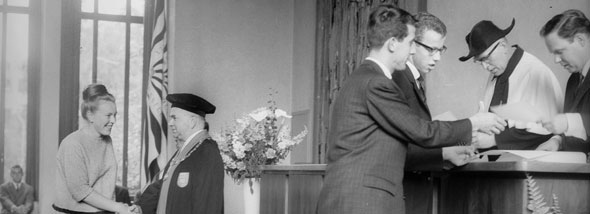
Educational reserve in the economic boom: the 1950s to the 1970s
During the boom years after the Second World War, Switzerland identified a significant educational shortfall. The notion of women as a “reserve” was introduced in discussions about educational policy.
During the economic boom of the 1950s and 1960s, labor became a scarce commodity. The demand for graduates in the job market far outstripped the number of graduates. While European countries that Switzerland took as a point of reference saw a significant increase in academic graduates from the early 1950s, student numbers in Switzerland initially remained stagnant. Concerns about “alarming neglect” in education policy and warnings of potential “underdevelopment” were voiced. Business leaders urged support for a new generation of students.
The federal government established commissions to determine the “anatomy of the shortage.” Steps were taken to incentivize prospective students (Federal Constitution Scholarship Article of 1963) and to expand university training capacities (National Higher Education Promotion Act of 1968). The increase in student numbers soon aligned with educational policy goals. From the late 1950s onward, the number of men studying at the university rose rapidly, followed shortly thereafter by women. The shift toward a “university for the masses” began. Alongside the promotional measures, rising prosperity favored this development. The relatively high costs of a university education could increasingly be managed by financially disadvantaged groups.
“Utilizing the reserve”
When calls then came to “utilize the educational reserve of women,” the emphasis was mainly on economic benefit. Women were to help address the labor shortage – not just in manual labor, like “guest workers,” but in academic fields as well. In 1963, the Federal Commission for Youth Issues highlighted Switzerland’s lagging position in Europe: it ranked low not only in the percentage of working woman academics but also in the proportion of women students. The Basel City Statistical Office remarked in the same year that the number of women high school graduates was “too meagre.” The “talent reserve of our people,” it noted, was not being sufficiently utilized.
This educational mobilization of the female workforce conflicted with prevailing norms. Particularly the employment of married women with children clashed with social expectations that women’s role was to be wives and that mothers firmly belonged “in the home.”
Associations, academics, and political parties fiercely debated the impact of “maternal employment” on the family. With the emergence of part-time work in the 1960s, the exclusion of mothers from the labor market was partially relaxed: as “additional earners” and “reentrants,” they were increasingly permitted to engage in employment. The practical compatibility of these work models with domestic “duties” helped ease the conflict between labor shortage and gender norms.
The role of women as an “economic buffer” in the labor market was unstable, their employment contingent on favorable economic conditions. The call for more women in education was primarily based on situational factors rather than the principle of equality.


